Andras Lab
Website of the lab of Professor Peter Andras
Research areas
Neuroscience - Computation with dynamic neural activity patterns
Complex systems - evolutionary systems, network analysis and systems theory
Machine learning and computational intelligence
Software engineeering
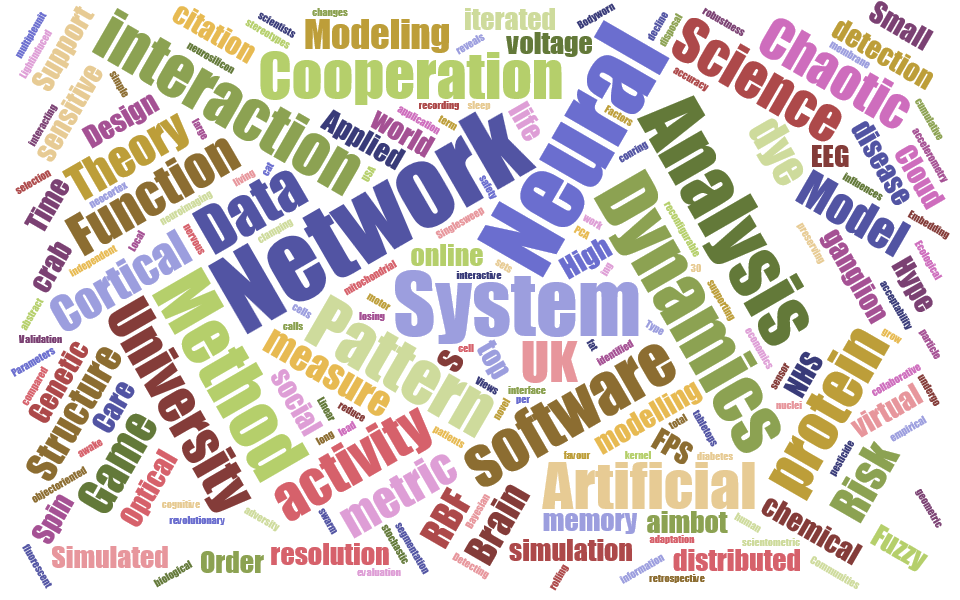
Neuroscience - Computation with
dynamic neural activity patterns:
We aim to understand how the dynamics of neural activity patterns leads to the emergent functionality of neural systems. A key question in this context is the variation of the role of individual neurons in the context of the neural circuits to which they belong.
Our work is currently focused on the experimental and computational analysis and computational modelling of the neurons and neural circuits in the crab stomatogastric ganglion (STG). For the experimental analysis we use voltage-sensitive dyes. We developed a detailed model of the pyloric circuit of the STG that allows the analysis of the impact of variations of conductance parameters of neurons on the functionality of neurons and of the neural networks to whcih these neruosn belong. We also work on the development of novel voltage-sensitive dyes for neuro-imaging in collaboration with chemistry colleagues (the group of Professor Andrew Benniston from Newcastle University).
Earlier we worked on the development and use of a probabilistic pattern transition language to describe and analyse high resolution EEG data.
The video article at the link presents the dye filling and recording of STG neurons: Stein, W, Staedele, Andras, P (2011). Optical imaging of neurons in the crabstomatogastric ganglion with voltage-sensitive dyes. Journal of Visualized Experiments, doi: 10.3791/2567.
The desheathed stomatogastric ganglion

Dye filled neuron in the stomatogastric ganglion

Dyed stomatogastric ganglion

Dye filled neurons in the stomatogastric ganglion
Previously we worked on model neural networks that perform computation by employing dynamic neural activity patterns. This work led to the Sierpinski neural networks. The spatio-temporal output of this network can be characterised in terms of Sierpinski triangles. By the interaction of such networks we can generate Sierpinski tuning functions. Such tuning functions can be used as basis functions to perform computational tasks with the Sierpinski brain (a large collection of Sierpinski neural networks).
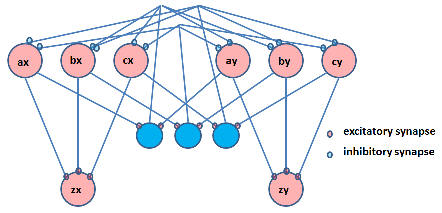
Sierpinski neural network
The output of the Sierpinksi network - the joint activity of the zx and zy neurons
Complex systems -
Evolutionary systems; Network analysis; Systems theory:
Our research in the area of complex systems is organised in three strands:
Evolutionary systems
Systems theory
Network analysis
Evolutionary systems
Our current work on agent-based modelling is about the analysis and
modelling of the emergence successful populations of humans,
animals, and plants. We also work on the role of social learning and
environmental factors on the emergence of forms of social
organisation. We explored recently the use of non-transitive games
(e.g. Rock-Paper-Scissor) in the context of emergence of
cooperation, considered as a model of social institution evolution.
Another recent direction of work is the analysis of open-ended
evolution using cellular automata based simulations.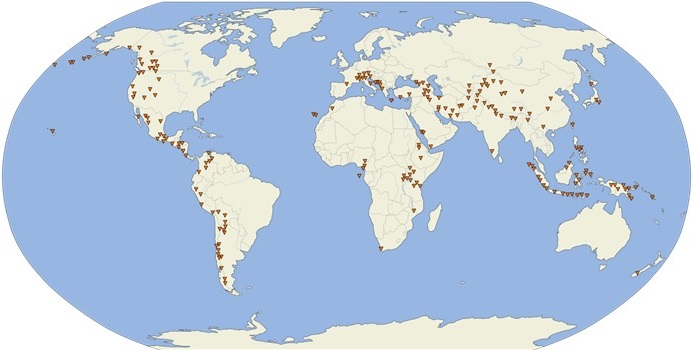
Predicted locations of origin of successful populations
We have worked on the evolution of cooperation in communities using agent-based simulations and game theoretic analysis since 2001. We developed a simulation framework to analyze the role of environmental uncertainty and harshness on the evolution of cooperative in an agent community. The simulation environment uses a simple parallel probabilistic formal language to describe agent communications (see details in the papers). The results show that there are strong relations between environmental risk and the level of cooperation within the community.
We have also worked on the role of communication between the agents and the evolution of the complexity of the language that they use to communicate.

Evolution of the level of cooperation (A), average communication length (B) and language variability (C) with positive draw Rock-Paper-Scissor games and clustered offspring.
Evolution of the level of cooperation in function of environmental uncertainty (the level of uncertainty is shown in the legend box).
Systems theory
Our work on systems theory focuses on the analysis of complex social and biological systems using methods of systems theory, building on works of Niklas Luhmann, Francisco Varela and Humberto Maturana. Our objective is to develop a better understanding of how these systems function, structure themselves and evolve.
Our most recent work is about systems theory analysis of decision making in organisations. Previosuly we worked on the emergence of communication inflation in social systems and on the evolutionary adaptation processes of such systems. We have considered the analysis of organisations as complex communication systems (e.g. using a representation based on email communications) with the aim of determining their informal structure and management decisional patterns. We also applied the theory of abstract communication systems to biological complex systems (protein interaction systems, neural systems) and artificial systems (software systems).
We have also worked on the application of systems theory concepts to the modelling of living systems and the exploration of open-ended evolution.

A bit-string individual (red - fixed outside, green - variable inside) in a cellular automata world.
An abstract communication system: the system is made of communications, while the communication units that generate these communications are not part of the system (see more details and explanations in our relevant papers)
Network analysis
Our aim is to develop new computational methods for network analysis of various natural and artificial systems. Over the years we developed methods to analyse cortical networks, ecological networks (food-webs), interaction networks of software components, and protein interaction networks.
Currently we use our software engineering research to explore the use of large scale software as a general testing ground for the assessment of the validity of network analysis methods for real world systems.
Previously, our work on protein interaction networks aimed to help drug target discovery and drug design. We analyzed interaction networks of proteins in various organisms, and develop methods to determine the functionally most important parts of these networks. We used this information to search for drug targets and advise the drug design procedure. The protein interaction network analysis was done in collaboration with the e-Therapeutics Plc, a university spin-off company (one of the leading startup biotech companies int he UK). The developed methodology has been patented.
The protein interaction network of a bacterium
Machine
learning and computational intelligence:
We are interested in using machine learning and computational intelligence tools to support decision making in various contexts. We also work on the theoretical foundations of these methods (approximation theory, kernel methods and Bayesian approaches).
Our current theoretical work is about the approximation of high-dimensional functions with combined supervised and unsupervised learning methods. Another direction of our recent theoretical work is the Bayesian interpretation and kernel extension of the particle swarm optinisation methods. We also work on the analysis of the impact of model complexity on the reliability of machine learning based data analysis (e.g. classification, prediction) and on the interpretational transparency of machine learning applications. We have also explored the aspect of trust in the context of interactions between humans and intelligent machines.
Recently we started working on the analysis of medical imaging data with the aim of early detection and prognosis for bone cancers in collaboration with medics.
We also work on the devlopment of privacy preserving machine learning algorithms that can be applied in distributed setting in the context of IoT devices integrated through fog and cloud computing systems.
Our recent applied work is about developing novel spam filters for social media using computational intelligence methods and the automation of literature search and classification in the context of automated support for sytematic literature reviews. We also continue our previous work on the analysis of accelerometer data to classify and analyse human movement and behaviour.
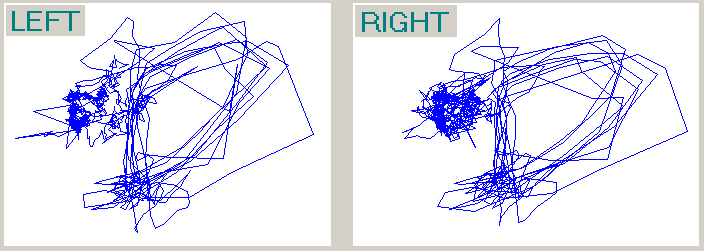
Simultaneous recording of acceleration data from left and right arms - the figure shows acceleration values in the two horizontal dimensions only.
Previously we used such techniques to support medical decision making. We looked at the possibilities of objective assessment of disease stage and progression in case of Parkinson's disease patients using accelerometers built into wearable computing devices.
We also considered developing applications to support group decision making through the of interactive touch sensitive tabletop devices.
We also worked earlier on the use of computational intelligence methods to analyse and classify mitochondrial proteins and to recognize and classify apoptotic cells.
Confocal image of cell nuclei
3D rendering of a set of simulated confocal images of nuclei.
Software engineering:
Our aim is to develop methods and tools that support the engineering of complex softare systems.
We work on the analysis of run-time class and object interaction networks in large-scale software and the development and validation of network analysis methods in this context. We look at the software using dynamic analysis methods in order to understand how components of the software actually interact to deliver the software functionality. We aim to show that network analysis methods can be used to improve the functionality of the software for example by helping the fixing of erroneous behaviour and determining parts of the software that require changes for improved or modified functionality.
Recently we extended our work into areas of information assurance in software-centric systems, cloud computing performance analysis and automated tools for systematic reviews in software engineering. We have explored the usability and security trade-off in the context of tools, services and technologies used in the context of eGovernment. We have investigated the statistical reliability and reproducibility of the use of machine learning tools in the context of evidence-based software engineering. We have developed novel metrics for scalability performance analysis of cloud-based software services.

The calculation of our scalability performance metrics for cloud-based software services: A) the volume scalability metric is hI, which is the ratio between the areas A and A* ; B) the quality scalability metric is ht, which is the ratio between the areas B* and B. The red lines indicate the ideal scaling behaviour and the blue curves show the actual scaling behaviour.
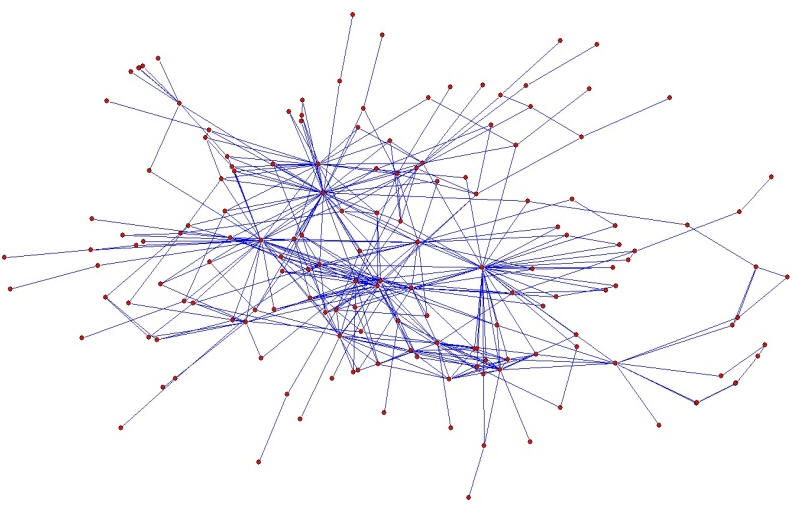
The dynamic class interaction network of the JHotDraw 6.01b software
Complex nonlinear neural dynamics - CNS / IJCNN Workshops
We were among the organisers of the complex neural dynamics workshops from 2001 - 2007. These workshops brought together theoretical and experimental neuroscientists with interest in dynamics and complex neural activity in order to facilitate the communication and collaboration between them. Between 2001- 2004 the workshops were organised as part of the annual Computational Neuroscience Symposium (CNS), after 2005 we organised the workshops as part of the International Joint Conference on Neural Networks (IJCNN).
2006 Workshop (Vancouver, Canada)
2005 Workshop (Montreal, Canada)
2003 Workshop (Alicante, Spain)
Interesting blogs and links
Videos from the Redwood Centre for Theoretical Neuroscience
Kurzweil - Accelerating Intelligence
Ars Technica - Information Technology
KDNuggets - data science, big data analytics
I Quant NY - quantitative finance
Statistical Modelling, Causal Inference and Social Science
Greg Mankiw's Blog - economics
Andrej Karpathy Blog (neural networks, machine learning)
BEACON Center (evolution, artificial life)
Michigan University Center for the Study of Complex Systems